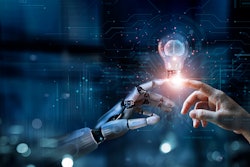
From container ships lining up outside of ports to empty shelves throughout stores, we’ve experienced significant disruptions to the global supply chain over the past few years. If these events taught business leaders anything, it’s that they have to make their supply chains more resilient moving forward. However, the changes required to create long-term supply chain resiliency – like diversifying manufacturing networks and multi-sourcing suppliers – won’t solve the immediate problems caused by pent-up demand or the ongoing labor shortage.
Rather than wait for solutions that won’t result in an immediate impact, logistics and supply chain leaders should consider implementing the latest technologies powered by artificial intelligence, such as demand forecasting and automated employee scheduling tools. While these innovations aren’t the panacea to all issues currently facing supply chains, they will play a role in making operations more efficient and helping create more productive workers – two essential components of resilient operations.
AI Enables Labor Efficiency
Supply chains are powered by people. Having the right person, in the right place, armed with the right skills at exactly the right time is crucial for meeting service levels and customer expectations. Considering this need, businesses must have accurate demand forecasting and an optimized labor plan for effective operations.
Businesses are already using customer and product data to create demand forecasts, taking into account things like how many operators they’ll need to support logistics and how many cases need to be loaded onto each truck. The problem is that data from the last few years is skewed due to the COVID-19 pandemic and increasingly unpredictable weather patterns, which makes it challenging to accurately predict the labor resources required to meet demand.
A workforce management (WFM) platform that uses AI to analyze both historical and real-time data empowers supply chain leaders to uncover the most up-to-date trends. In fact, machine learning engines react to the likely volatility of data to create a more accurate forecast, taking into account factors like weather, holidays and special events to determine what demand will be at any given time so businesses can resource appropriately.
Better yet, machine learning-based solutions are self-learning. The more data the model ingests over time, the smarter it becomes. This allows organizations to rapidly improve their demand forecasting capabilities and address labor needs accordingly.
AI Improves the Employee Experience
Not only have businesses experienced a slew of supply chain disruptions in the past two years, but they’ve also had to navigate an ongoing labor shortage at the same time. If supply chain leaders hope to attract and, more importantly, retain the talent they need to operate, they must first understand what their people want from an employment opportunity.
Legion Technologies' research uncovered the three major factors that contribute to overall employee satisfaction:
- Schedule empowerment – 59% of employees surveyed cited issues with scheduling as a reason to quit a job.
- Good communication – 39% of those surveyed said they would leave their current job if the employer was a poor communicator.
- Early access to wages – 75% said they would like the option to receive their pay early.
Having a better understanding of what employees want and need will enable supply chain leaders to build a better employee experience. For example, businesses can adopt WFM solutions that provide employees with more autonomy over their work schedules, enabling automated scheduling that matches business needs with employee preferences, and allowing employees to swap shifts as needed. With the latest WFM platforms, leaders can also offer employees tools for more effective communication with management and colleagues, as well as early access to wages that drive schedule adherence and increase employee morale.
Different influences can affect the supply chain - some have linear effects, while others have non-linear effects - so determining certain outcomes is not always straightforward. Our world will continue to be reshaped by the pandemic despite the progress we have made in overcoming its challenges. However, we've learned that people are the backbone of supply chains and ensuring they have what they need also helps businesses succeed. Those who use AI to focus on what they can control will be better positioned to mitigate the challenges ahead.


















![Pros To Know 2026 [color]](https://img.sdcexec.com/mindful/acbm/workspaces/default/uploads/2025/08/prostoknow-2026-color.mduFvhpgMk.png?ar=16%3A9&auto=format%2Ccompress&bg=fff&fill-color=fff&fit=fill&h=135&q=70&w=240)
